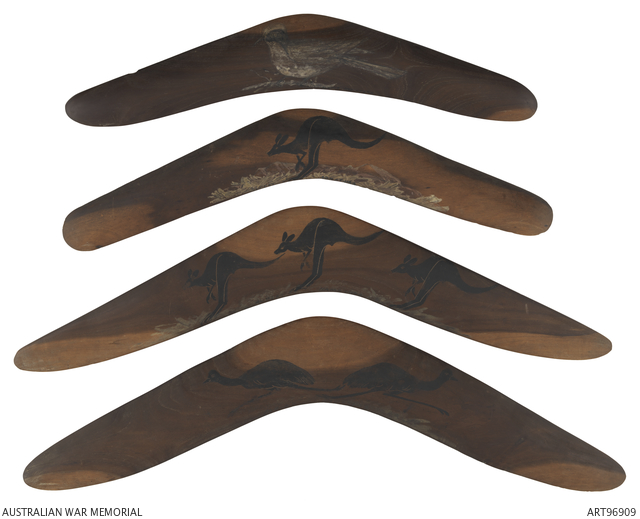| Place | Oceania: Australia, Northern Territory |
|---|---|
| Accession Number | ART96909 |
| Collection type | Art |
| Measurement | various |
| Object type | Applied/Decorative art |
| Physical description | natural earth pigments on mulga wood |
| Maker |
Namatjira, Albert |
| Place made | Australia: Northern Territory, Hermannsburg |
| Date made | c.1945 |
| Conflict |
Second World War, 1939-1945 |
| Copyright |
Item copyright: AWM Licensed copyright |
not titled [four decorated boomerangs]

This graduated grouping of boomerangs were created by Albert Namatjira (1902–1959) of the Western Aranda peoples, who remains one of the most well-known and revered Australian artists. Namatjira is best known for his prolific landscape watercolour paintings that are seen as expressions of traditional sites and sacred knowledge.
The boomeranges were purchased by NX89508 Sergeant Roy Stanley Kidman from Ntaria (Hermannsburg). Ntaria is an Aboriginal community and the location of the former Hermannsburg mission established by German Lutheran missionaries in 1877, located 125km south west of Mparntwe (Alice Springs) in the Northern Territory. It is famous as the birth place of Albert Namatjira, who pioneered the Hermannsburg School of landscape painting in watercolours during the late 1930s. The mission was visited by troops and dignitaries during this period and most likely where Sergeant Kidman purchased the boomerangs.
Sergeant Kidman was born in Petersham, NSW in 1903. He enlisted on 20 February 1942, and at the time of discharge was serving as a Sergeant in 1 Australian Marine Food Supply Platoon. This unit was part of the Australian Army Supply Corp which saw service in all theatres during the Second World War (SWW) including Northern Australia. Sergeant Kidman was one of the 400,000 men and women who served in Australia during the SWW. They supplied essential war material to the fighting troops, maintained the lines of communication and provided medical support.
Between 1942 and 1945 Alice Springs was the main staging point for the mobilisation of the military north to Darwin. Consequently there was a huge movement of servicemen and women, as well as residents evacuated from Australia's northern towns and cities passing through Alice Springs. For many service personnel it was the first time that they had visited Central Australia and encountered Aboriginal communities. For some, recreational periods became an opportunity for cultural tourism. The Memorial has numerous photographs of troops exploring the now well-known destinations of Central and Northern Australia such as Palm Valley in Finke Gorge National Park, Karlu Karlu (the Devil Marbles), and Tjoritja (the McDonald Ranges). They were also photographed watching performances of Corroborees and learning about Indigenous hunting practices, including the use of boomerangs.